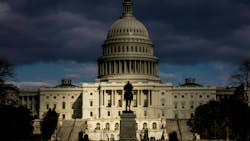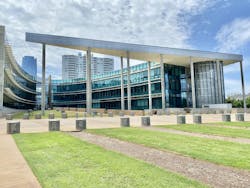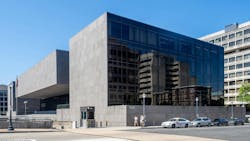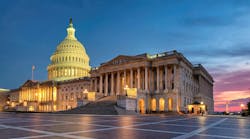COMMENTARY | Architectural Community Responds to Trump’s Executive Order on Federal Design
On Tuesday, September 2, 2025, i+s received an email statement from the American Institute of Architects (AIA) regarding President Trump’s late August enactment of the executive order “Making Federal Architecture Beautiful Again.”
Readers can access the AIA statement in full on the association’s website, so I won’t repeat it in its entirety. In brief: AIA has made it clear that a mandate to employ “classical architectural styles” (a) restricts thoughtful federal building and site design by removing local residents’ feedback from the process, which (b) limits design teams’ ability to reflect modern culture and deliver designs that serve diverse societal needs. And this organization does not stand alone in its concerns.
This policy issue is by no means new. Multiple associations responded to the initial executive order in 2020, as well as earlier this year. Supporting concerns expressed by AIA and the American Society of Landscape Architects (ASLA), the Society of Architectural Historians (SAH) and the Society for Classical Studies (SCS) penned a joint letter to the Trump Administration in February 2020, strongly opposing the order’s language and urging a return to values outlined in the 1962 publication Democratic by Design: Guiding Principles for Federal Architecture.
As a government agency, GSA has for many years now followed those guiding principles for federal architecture, resulting in landmarks such as the U.S. Tax Court Building in D.C. (1974) and the rebuilt Alfred P. Murrah Federal Building in Oklahoma City (2004), which have been widely acknowledged as examples of design excellence.
Despite their clear differences in location and eras in which they were constructed, both structures stand as representations of evolving modern design ingenuity, visual solidity and strength, and the limitless vision that has long been deemed “American.”
Under the revived executive order, federal building designs with these aesthetic characteristics would no longer be approved. Furthermore, the order states, “President George Washington and Secretary of State Thomas Jefferson […] sought to use classical architecture to visually connect our contemporary Republic with the antecedents of democracy in classical antiquity, reminding citizens not only of their rights but also their responsibilities in maintaining and perpetuating its institutions.”
I would argue that it is the responsibility of our contemporary Republic to consider architectural designs that respond to contemporary social and environmental issues, through (but not limited to) the following practices:
- Efficient use of materials and resources that limit harm to the local ecosystem
- Utilizing advanced technology and building research to improve the experience of the American public
- Providing citizens with an opportunity to shape their physical communities while respecting and preserving historic architecture—including classical styles among others—through renovation and adaptive reuse projects
Through these practices, our government buildings will reflect the rich heritage of architecture for which our country is known.
Both in 2020 and today, voices representing the A&D community have urged the Administration to maintain a legacy of engaging local input on federal building design decisions, rather than delivering mandates that may not align with the evolution of architectural design standards and community needs.
From the SAH/SCS opposition letter in 2020:
“[Democratic by Design] encouraged both architectural practitioners and government officials to look for ways to express the ideals of American democracy in architectural form by looking to voices of the American public, rather than the amplification of a federal dictate from on high.”
From the Boston Society of Architects, in response to revival of the executive order in January 2025:
“We strongly believe that a building’s designs and character should reflect the diverse populations that make up our communities. The BSA supports a wide range of design styles and stands by the principle that architecture must honor local identity and culture, with design reflecting the unique values of the people of our Commonwealth.”
From ASLA in March 2025:
“ASLA supports the active and intentional engagement of the community and stakeholders in all phases of planning, design, and implementation processes for projects that contribute to the public realm, which builds consensus, trust, mutual understanding, and shared decision-making.”
From SAH in July 2025:
“We affirm our support for a renewed national dialogue around architectural excellence—one that advances a civic architecture that is enduring, innovative, and democratic in both process and expression.”
From AIA in September 2025:
“Federal buildings should reflect the community and regional character while maintaining high design standards. America deserves federal buildings that inspire and serve our communities through excellent design that respects both our heritage and our future.”
Throughout those statements, variations on the themes of “democracy,” “freedom,” “values,” “principles,” “community,” and respect for architectural heritage and future are evident.
I fully support a democratic, evidence-based, and future-forward approach to federal and public building design that clearly represents and serves all American people. In my view, architecture should reflect our changing understanding of what it means to be a community, evolving and united in purpose and execution, rather than mirror the past.
*These statements are opinions expressed by our editor and are not necessarily representative of those of i+s as a brand or of its parent company, EndeavorB2B.
Picks from Our Editor
About the Author
Carrie Meadows
Editor-in-Chief
Carrie Meadows is Editor-in-Chief of interiors+sources (i+s), where she leads editorial strategy, content development, and brand storytelling focused on the people, projects, and innovations shaping the design industry. With more than two decades of experience in B2B media, she has built a career connecting technical expertise with creative insight—translating complex topics into meaningful stories for professional audiences. Before joining i+s in 2024, Carrie served as Editor-in-Chief of LEDs Magazine within Endeavor Business Media’s Digital Infrastructure & Lighting Group, guiding coverage of emerging lighting technologies, sustainability, and human-centric design. Her earlier editorial experience spans across Laser Focus World, Vision Systems Design, Lightwave, and CleanRooms, where she managed print and digital publications serving the optics, photonics, and semiconductor sectors.
An advocate for clear communication and thoughtful storytelling, Carrie combines her editorial management, SEO, and content strategy expertise to help brands and readers stay informed in a rapidly evolving media landscape. When she’s not crafting content, Carrie can be found volunteering at a local animal shelter, diving into a good crime novel, or spending time outdoors with family, friends, and her favorite four-legged friends.






